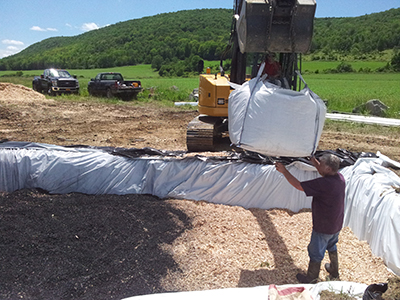Feeding our crops and protecting our water with bioreactors and controlled drainage
Bioreactors and controlled drainage expand options for feeding our crops and protecting our water.

Much of the most productive farmland in the Great Lakes region is tile drained. Tile drainage removes excess water, improves infiltration, increases water storage and reduces runoff, and increases crop yields. While tile drainage provides economic and environmental benefits, heavy rainfall can move crop nutrients through the root zone to tile drains where they can escape to the environment. Healthy soil is porous so soil systems leak. Because of problems related to excess nutrients in the Saginaw Bay, Lake Erie, the Gulf of Mexico and other areas, there is a lot of interest in managing drained crop land to retain drainage water for crop use and recycle crop nutrients.
Larry Geohring has been at Cornell University since 1977 working on drainage water management issues with the objective of improving drainage design and management to sustain crop production and minimize nutrient loss through tile drain discharge. He recently spoke at a conference co-sponsored by the Michigan Chapter of the Soil and Water Conservation Society and Michigan State University Extension about using controlled drainage and bioreactors to reduce nutrient loss from drained cropland. Most fields are freely drained whereby the tile drain outlets are installed and maintained at a constant height and require little management. Controlled drainage is the process of using control structures – usually located at the outlets – to hold back or release drainage water by raising or lowering the height of the outlet. A bioreactor is a structure that contains a carbon source – often woodchips – that intercepts and contains subsurface drain flow to reduce the concentration of nutrients.
Tile drainage increases water storage and reduces runoff, but because soil systems are porous, some nutrient movement to tile drains is unavoidable after large rainfall events. Particulate phosphorus (P) is linked to erosion and is about 26 percent bioavailable and tends to settle out of the water column. Surface runoff typically carries sediment and more total phosphorus (particulate plus dissolved phosphorus, DP) than drainage water; however, drainage water carries a greater percentage of DP which is nearly 100 percent bioavailable. This is alarming because DP stays in the water column and is 100 percent bioavailable for algae and aquatic plants.
A typical drainage control structure consists of a riser at the tile outlet with movable barriers to raise or lower the height of the outlet and in doing so the height of the water level. A reasonable management approach is to set the control barriers high after harvest and through the winter to hold back nutrients and excess water, then lower them in the spring to drain excess water and prepare for planting. During the growing season, the barriers can be raised to an intermediate level to retain water for crop growth, or they can be raised prior to an anticipated rainfall or nutrient application to hold back the initial surge of drainage water and then lowered as conditions allow. By holding back the initial flow of drainage water, the P has time to sorb to the soil matrix and be retained in the root zone for crop growth.
Based on the results of his work in New York, Geohring expects a 10 to 20 percent reduction in the total P load – the product of the total water discharge times the P concentration – with properly managed control structures compared to conventional free drainage. The control structures held back some of the drainage water, reduced the total drainage discharge and reduced the initial high spike in P concentration, thereby reducing the total P load. The use of control structures did not change the ratio of DP to total P; DP was about 80 percent of total P with free drainage or the use of control structures.
Denitrification is a biological process whereby organisms use a carbon source to convert nitrate to nitrogen gas under anaerobic conditions. The nitrogen gas is then lost to the atmosphere. Bioreactors typically reduce nitrate concentration in drainage water by about 50 percent. Geohring is in the process of evaluating six bioreactors on farmland in New York. The bioreactors are installed in pairs at three sites. Each site has a bioreactor with woodchips alone as the carbon source and one with woodchips plus biochar. Biochar is a fine-grained, porous, charcoal soil amendment that effectively adsorbs nutrients, and is very effective at retaining P. He uses drainage control structures to maintain the desired water level and a retention time of four to 12 hours in the bioreactors.

Construction of a bioreactor with alternating layers of woodchips and biochar for nitrogen and phosphorus removal.
Biochar was added to the woodchips in the bioreactors to capture and retain P in the bioreactor, but so far the results of Geohring’s work have been inconsistent. There was no reduction in P at one of the sites, but the P concentration of the incoming water was low. A second site where manure had been applied showed a two-thirds reduction in P concentration. One drawback to bioreactors is the size of the structures needed. Each of Geohring’s bioreactors required 200 square feet of land and about 26 cubic yards of woodchips. Nitrogen removal was about 4 pounds N per cubic yard of woodchips per year, about 100 pounds of nitrate per each year for each bioreactor.
Farm managers can reduce the risk of crop nutrient loss in runoff and drainage discharge by controlling application rates, methods, timing and placement, but even the best managed cropland is vulnerable to nutrient loss following heavy rainfall. Bioreactors and controlled drainage expand the options available for feeding our crops and protecting our water under challenging conditions.



 Print
Print Email
Email
